The selectivity of beta-adrenoceptor agonists at human beta1-, beta2- and beta3-adrenoceptors
- PMID: 20590599
- PMCID: PMC2936015
- DOI: 10.1111/j.1476-5381.2010.00754.x
The selectivity of beta-adrenoceptor agonists at human beta1-, beta2- and beta3-adrenoceptors
Abstract
Background and purpose: There are two important properties of receptor-ligand interactions: affinity (the ability of the ligand to bind to the receptor) and efficacy (the ability of the receptor-ligand complex to induce a response). Ligands are classified as agonists or antagonists depending on whether or not they have efficacy. In theory, it is possible to develop selective agonists based on selective affinity, selective intrinsic efficacy or both. This study examined the affinity and intrinsic efficacy of 31 beta-adrenoceptor agonists at the three human beta-adrenoceptors to determine whether the current agonists are subtype selective because of affinity or intrinsic efficacy.
Experimental approach: Stable clonal CHO-K1 cell lines, transfected with either the human beta(1), beta(2) or beta(3)-adrenoceptor, were used, and whole-cell [(3)H]-CGP 12177 radioligand binding and [(3)H]-cAMP accumulation were measured.
Key results: Several agonists were found to be highly subtype selective because of selective affinity (e.g. salmeterol and formoterol, for the beta(2)-adrenoceptor over the beta(1) or beta(3)), while others (e.g. isoprenaline) had little affinity-selectivity. However, the intrinsic efficacy of salmeterol, formoterol and isoprenaline was similar across all three receptor subtypes. Other ligands (e.g. denopamine for beta(1); clenbuterol, AZ 40140d, salbutamol for beta(2)) were found to have subtype-selective intrinsic efficacy. Several ligands appeared to activate two agonist conformations of the beta(1)- and beta(3)-adrenoceptors.
Conclusions and implications: There are agonists with subtype selectivity based upon both selective affinity and selective intrinsic efficacy. Therefore, there is scope to develop better selective agonists based upon both selective affinity and selective intrinsic efficacy.
Figures
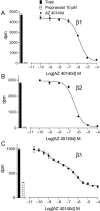
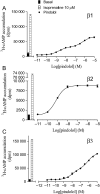
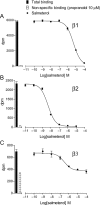
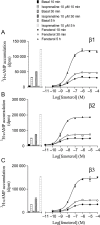
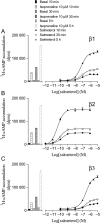
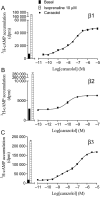

Comment in
-
Being mindful of seven-transmembrane receptor 'guests' when assessing agonist selectivity.Br J Pharmacol. 2010 Jul;160(5):1045-7. doi: 10.1111/j.1476-5381.2010.00764.x. Br J Pharmacol. 2010. PMID: 20590598 Free PMC article.
References
-
- Baker JG. Evidence for a secondary state of the human β3-adrenoceptor. Mol Pharmacol. 2005b;68:1645–1655. - PubMed
MeSH terms
Substances
LinkOut - more resources
Full Text Sources
Other Literature Sources
Medical
Molecular Biology Databases

